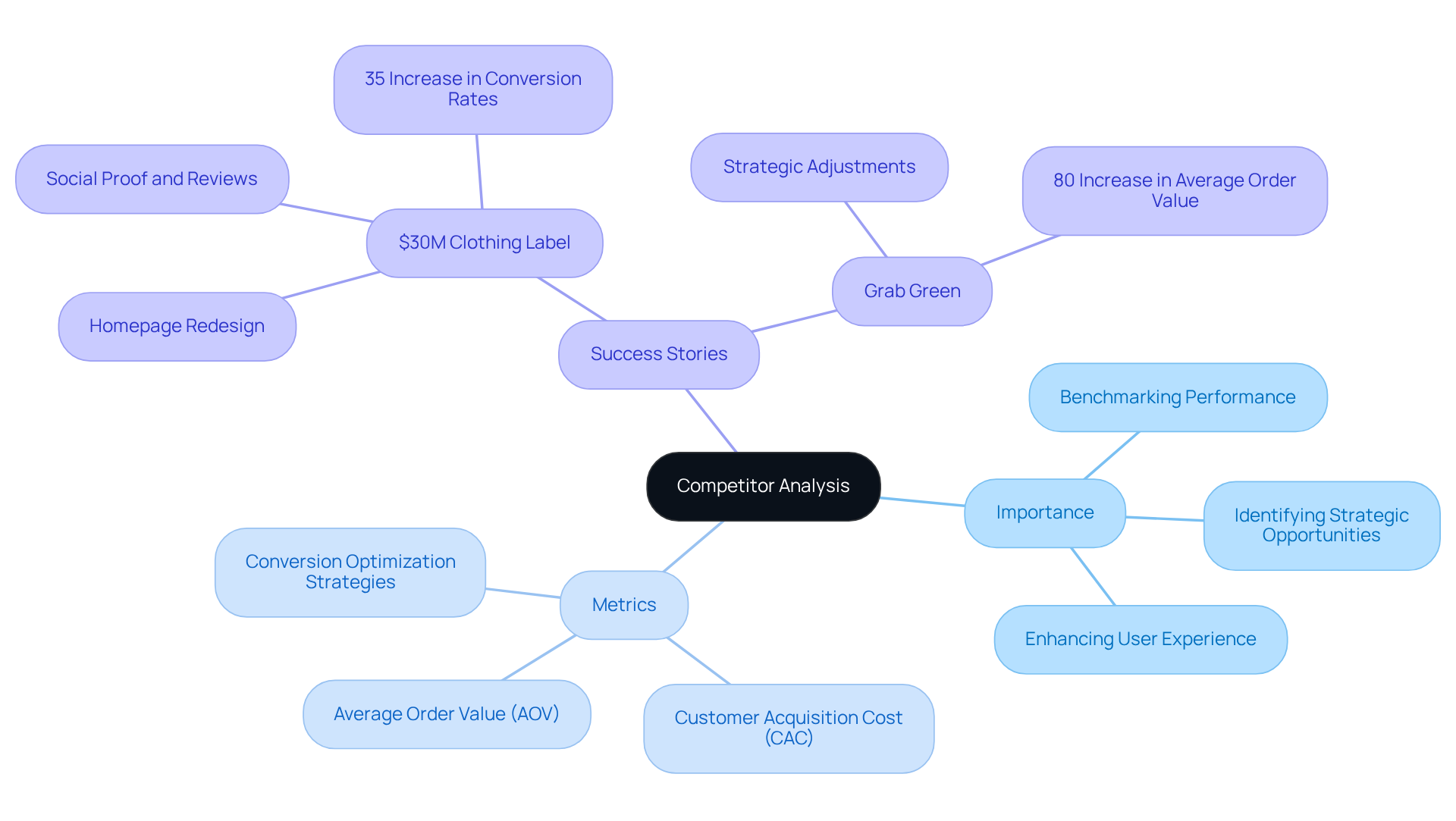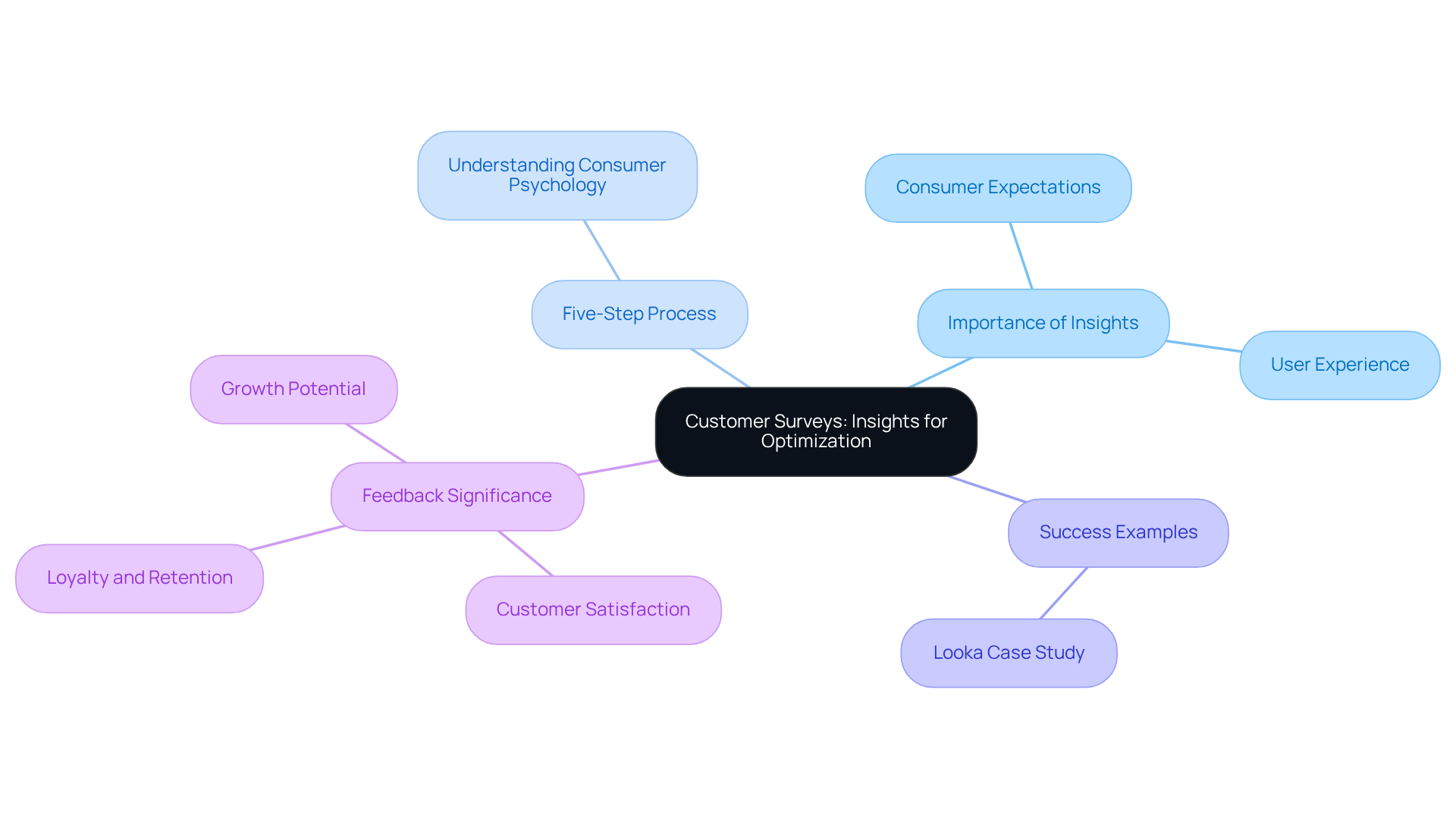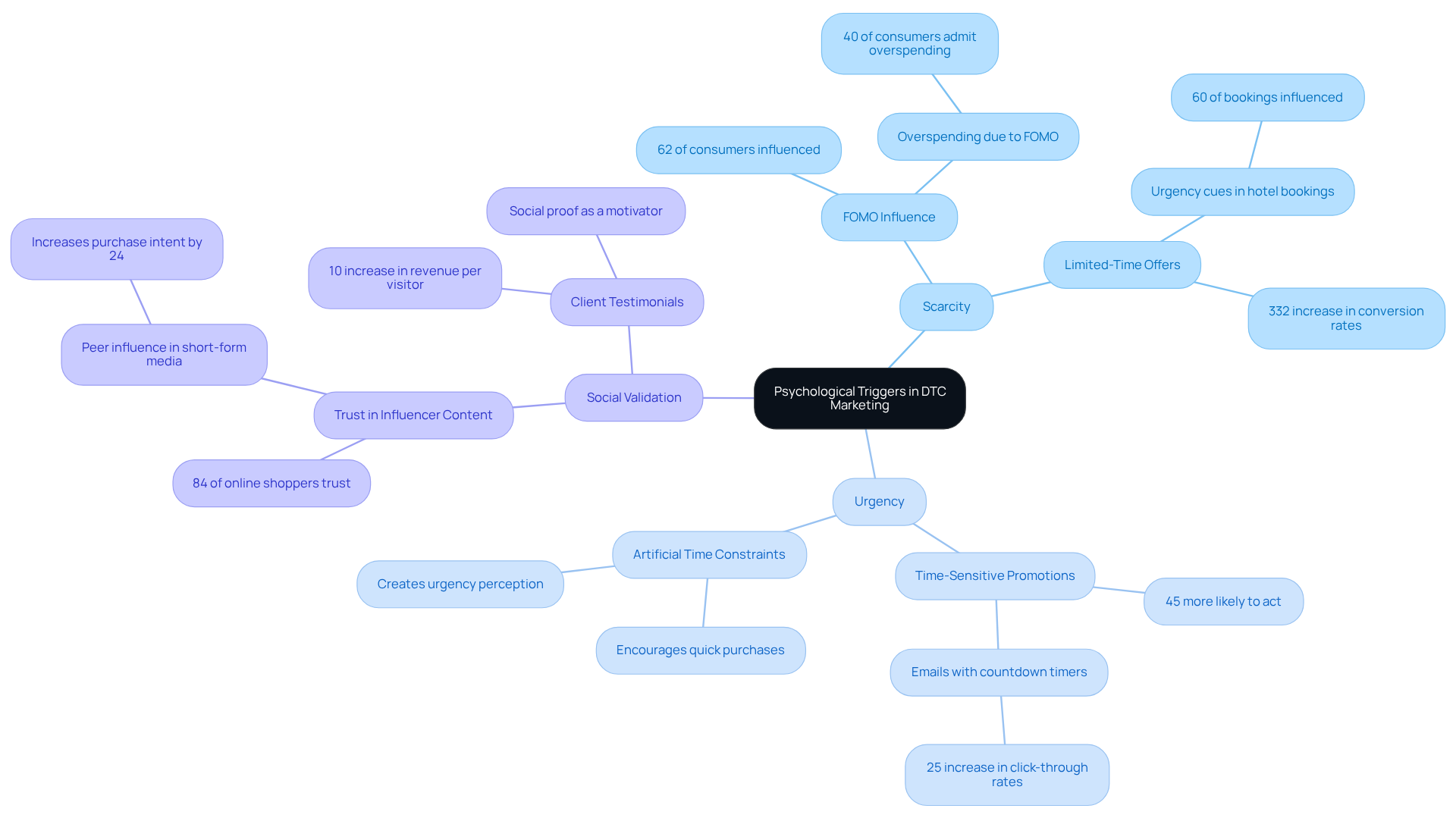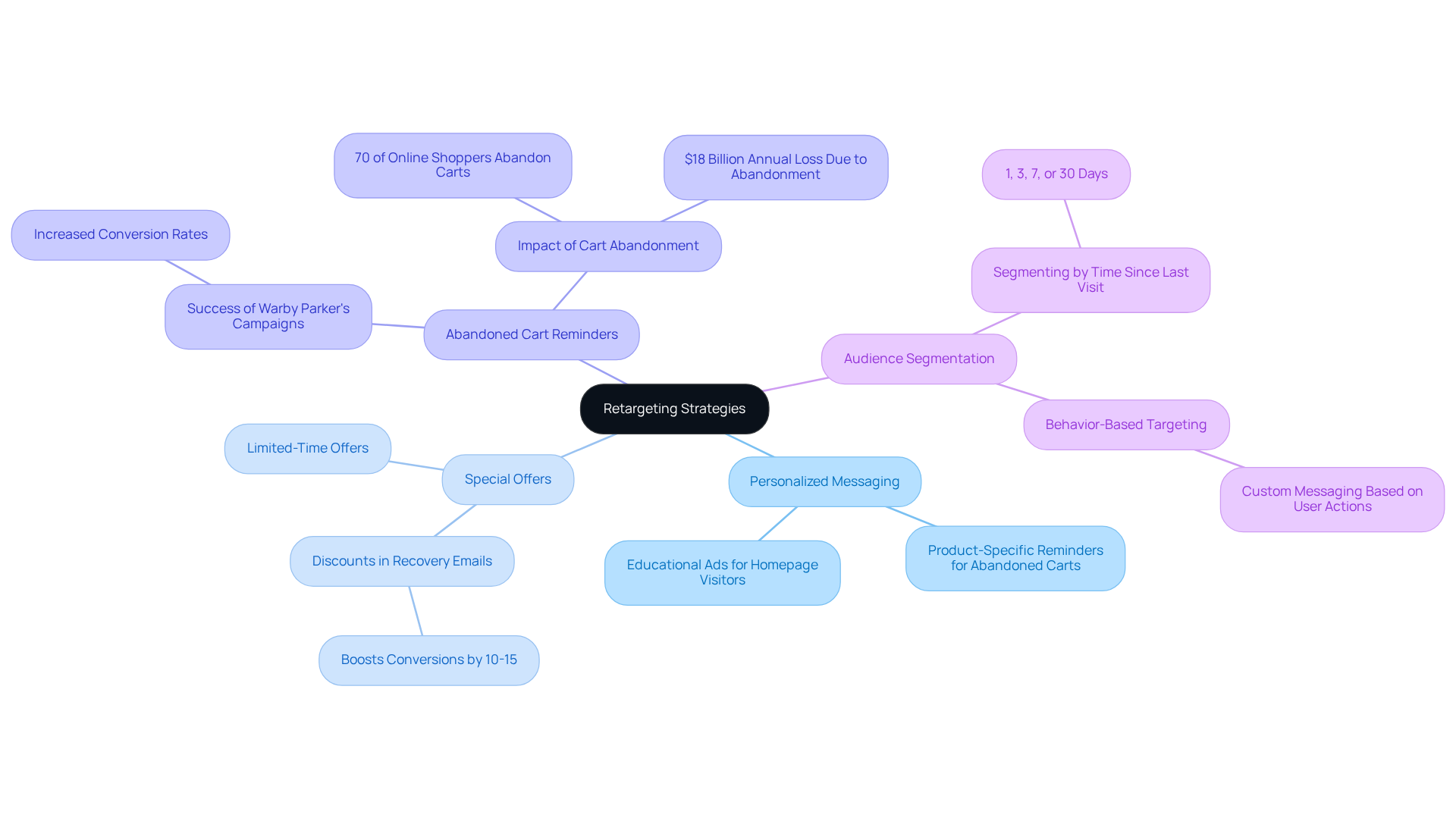
Overview
This article presents ten essential conversion optimization strategies tailored for direct-to-consumer (DTC) brands. It delves into critical methods such as:
- A/B testing
- User session recordings
- Competitor analysis
- Effective copywriting
All aimed at enhancing customer engagement and driving sales. Each strategy is fortified by real-world examples and data, underscoring the potential of these approaches to significantly elevate conversion rates and overall business performance within a competitive digital landscape.
Introduction
In the fiercely competitive landscape of direct-to-consumer (DTC) brands, mastering conversion optimization strategies is no longer optional—it's essential for survival and growth. Companies are constantly seeking innovative ways to enhance their profitability and engage customers effectively. This article explores ten vital strategies that can transform a DTC brand's approach to conversions, offering insights into data-driven techniques and best practices. However, as the digital marketplace evolves, brands must not only keep pace but thrive amidst the rapid changes.
Parah Group: Comprehensive Conversion Rate Optimization Services
Parah Group stands at the forefront of conversion optimization strategies, dedicated to maximizing profitability for direct-to-consumer companies. Their extensive offerings encompass:
- User session recordings
- Competitor analysis
- Persuasive copywriting
- UI/UX design
- Customer surveys
- Ongoing A/B testing
Each service is meticulously executed to ensure that every aspect of a client's website and marketing strategy is optimized for growth, effectively addressing the unique challenges faced by companies in a competitive landscape.
By leveraging data-driven insights and expert analysis, Parah Group not only enhances user experience but also employs conversion optimization strategies to drive conversion rates. Their strategic approach includes conversion optimization strategies that guarantee clients are equipped with the tools necessary to outperform competitors and achieve sustainable success.
In a world where digital presence is paramount, Parah Group’s commitment to ongoing A/B testing and iterative improvements ensures that their clients remain agile and responsive to market changes. This proactive stance not only fosters growth but also instills confidence in clients as they navigate the complexities of the digital marketplace.

A/B Testing: Optimize Your Landing Pages for Higher Conversions
A/B testing stands as a cornerstone of conversion optimization strategies, which are pivotal for comparing two versions of a webpage to determine which yields superior results. By methodically testing elements like headlines, images, and calls to action, direct-to-consumer (DTC) companies can identify the most effective combinations that enhance user engagement and drive sales.
At Parah Group, we believe that A/B testing is merely the beginning. Our comprehensive five-step process delves into consumer psychology, ensuring that every facet of your landing pages is meticulously optimized for maximum profitability.
Regularly conducting A/B tests, in conjunction with our rigorous testing methodologies and the strategic alignment of paid advertisements with landing pages, ensures that your conversion optimization strategies remain flexible in response to shifting consumer preferences. This adaptability ultimately cultivates significant growth and elevates performance for your business.

User Session Recordings: Analyze Customer Behavior to Enhance Conversions
User session recordings capture real-time interactions of visitors on a website, providing valuable insights into their behavior. These recordings enable companies to pinpoint pain points, such as unclear navigation or unproductive calls to action, that may impede results. This data-focused method allows companies to apply conversion optimization strategies that enhance user experience and elevate success levels.
For instance, Parah Group has effectively implemented conversion optimization strategies that led to a 35% rise in conversion rates and a 10% enhancement in average order values for various direct-to-consumer companies. By concentrating on enhancing user interactions through conversion optimization strategies, organizations can significantly influence their profitability and attain sustainable growth.
In conclusion, leveraging user session recordings not only improves user experience but also empowers companies to drive their success forward.

Competitor Analysis: Learn from Industry Leaders to Boost Your Strategy
Conducting a thorough competitor analysis is vital for DTC companies seeking to benchmark their performance against industry leaders. By scrutinizing competitors' strengths and weaknesses, brands can pinpoint gaps in their own strategies and discover opportunities for enhancement. This examination guides essential choices about pricing and messaging while enhancing user experience, which is crucial for improving success outcomes. Companies that have successfully conducted competitor analysis have reported notable enhancements in their performance metrics, with some attaining boosts of up to 30% in success percentages after adjusting their strategies based on insights acquired.
A significant instance is a $30M clothing label that collaborated with Parah Group, which faced challenges with low sales performance. By redesigning their homepage to highlight social proof and reviews, optimizing product pricing, and implementing gamified elements, they employed effective conversion optimization strategies that resulted in a remarkable 35% increase in conversion rates. Similarly, Grab Green, a $15M cleaning product company, improved their average order value (AOV) by 80% through strategic adjustments informed by competitor analysis, such as testing free shipping thresholds and adding bundles to incentivize larger purchases.
Marketing analysts highlight the significance of benchmarking against industry leaders, observing that comprehending a company's position relative to its competitors can inspire strategic modifications that result in improved performance. Present benchmarks for DTC companies suggest that an average success percentage hovers around 2-3%, but those who actively participate in competitor analysis often surpass this average by utilizing insights to improve their offerings. Key metrics to consider when benchmarking against competitors include:
- Average order value (AOV)
- Customer acquisition cost (CAC)
- The effectiveness of conversion optimization strategies
By concentrating on these metrics, DTC companies can establish a more competitive advantage and promote sustainable growth.

Conversion Copywriting: Craft Compelling Messages that Drive Action
Conversion copywriting is essential for DTC companies striving to craft persuasive and engaging content that compels visitors to take decisive actions, such as making purchases or signing up for newsletters. By delving into the target audience's pain points and desires, companies can formulate messages that resonate profoundly and inspire action. Effective copywriting not only enhances the overall user experience but also significantly boosts the rate of successful transactions.
In 2025, the latest trends in persuasive copywriting underscore the significance of clarity and emotional connection. Brands are increasingly leveraging storytelling techniques that evoke emotions, rendering the content relatable and memorable. For instance, successful DTC brands often employ testimonials and social proof to foster trust and credibility, which are pivotal for converting hesitant visitors into loyal customers.
Crafting copy that drives conversions entails several key strategies:
- Clear Calls-to-Action (CTAs): Effective CTAs direct users toward the desired action, whether it's completing a purchase or signing up for a newsletter. Phrasing such as 'Get Your Discount Now' or 'Join Our Community' instills urgency and encourages immediate engagement.
- Personalization: Customizing messages for specific audience segments enhances relevance and amplifies the likelihood of conversion. Tailored recommendations based on prior interactions can significantly elevate customer engagement.
- A/B Testing: Experimenting with different copy variations allows companies to identify which messages resonate most effectively with their audience. A minor alteration in wording can lead to substantial increases in conversion rates, as demonstrated by a 12% revenue boost from optimized ad headlines in a recent case study.
Successful examples of persuasive copy prompting action in DTC marketing often involve companies that implement conversion optimization strategies through emotional storytelling and relatable scenarios. By connecting with clients on a personal level, these brands not only refine their messaging but also nurture a sense of community and loyalty.
As the DTC landscape continues to evolve, remaining informed about the latest trends in persuasive writing is paramount. Brands that prioritize engaging, action-oriented content will not only enhance their success in attracting customers but also cultivate enduring connections with them, ensuring sustainable growth in an increasingly competitive market.

UI/UX Design: Create Engaging Experiences that Convert Visitors
UI/UX design is essential in creating a seamless and enjoyable experience for website visitors. A well-organized website not only attracts users but also effectively guides them through the transformation process. Key elements such as intuitive navigation, responsive design, and visually appealing layouts are crucial. Research indicates that effective UX can boost sales performance by as much as 400%, underscoring the importance of prioritizing UI/UX design for DTC companies. Furthermore, 81% of clients are willing to pay more for an enhanced user experience, which highlights the financial benefits of investing in effective design strategies. By focusing on user-centered design, companies can significantly enhance user satisfaction, which is crucial for implementing effective conversion optimization strategies, leading to increased engagement and higher conversion rates. As one designer insightfully states, 'A seamless and intuitive digital experience is a powerful differentiator that directly impacts your bottom line, from customer acquisition costs to lifetime value.

Customer Surveys: Gather Insights to Inform Your Optimization Strategy
Customer surveys serve as a vital instrument for DTC companies seeking to gather direct insights from their users. By posing targeted questions about experiences, preferences, and challenges, companies can unveil critical elements that influence outcomes. For instance, surveys can reveal consumer expectations concerning product offerings and website usability, enabling companies to refine their strategies accordingly.
At Parah Group, we harness these insights as part of our comprehensive five-step process aimed at enhancing profitability through conversion optimization strategies. By understanding consumer psychology, we tailor our approach to improve success metrics, ultimately fostering sustainable growth for DTC brands. Numerous successful instances highlight how client feedback has led to significant improvements in sales rates. A prime example is Looka, a web-based logo creator, which utilized surveys to understand why potential clients abandoned their carts, leading to adjustments that bolstered their overall conversion strategy.
Moreover, brands that actively engage in feedback collection frequently witness a considerable increase in customer satisfaction and loyalty. Research indicates that companies attentive to their clients grow ten times faster than those that are not. Key questions to consider in consumer surveys include those regarding product satisfaction, website navigation ease, and specific challenges encountered during the purchasing process. These inquiries not only yield valuable insights but also demonstrate to clients that their opinions are appreciated, fostering a sense of community and engagement.
Market analysts emphasize the significance of integrating client feedback into conversion optimization strategies. As one expert aptly noted, "Feedback is the compass for greatness; it tells you what to avoid, what to learn, and where to excel." By leveraging customer insights, DTC companies can refine their marketing messages, enhance user experience, and ultimately drive higher conversion rates.

Ongoing A/B Testing: Continuously Improve Your Conversion Strategies
Continuous A/B testing is a cornerstone for DTC companies utilizing conversion optimization strategies to adapt to evolving consumer behaviors and preferences. By persistently testing and refining various elements of their websites and employing conversion optimization strategies, these companies can sustain relevance and effectiveness within a competitive landscape. This iterative approach not only elevates success levels but also cultivates a culture of data-informed decision-making across the organization.
Recent advancements in A/B testing methodologies underscore the significance of rapid execution and actionable insights, empowering companies to pivot swiftly based on real-time data. For instance, a $30M clothing label that revamped its homepage and optimized product pricing reported an impressive 35% increase in sales rates and a 10% rise in revenue per visitor. In a similar vein, Grab Green, a $15M cleaning product company, experienced an 80% surge in average order value (AOV) by implementing strategic bundles and free shipping thresholds. These successful examples of iterative testing highlight that companies willing to experiment and embrace calculated risks can uncover hidden opportunities, ultimately leading to extraordinary outcomes in their strategies.
As John A. Shedd aptly remarked, 'A ship in harbor is safe, but that is not what ships are built for.' This statement emphasizes the necessity of venturing beyond comfort zones to unlock growth potential.

Psychological Triggers: Leverage Consumer Psychology to Enhance Conversions
Employing psychological triggers such as scarcity, urgency, and social validation can significantly enhance success metrics for direct-to-consumer (DTC) companies. Notably, research indicates that 62% of consumers assert that the fear of missing out (FOMO) influences their online purchasing behavior. This insight underscores the necessity for companies to craft marketing messages that resonate with this sentiment.
For instance, Parah Group successfully implemented time-sensitive promotions and revamped their homepage to highlight social proof for a $30 million apparel brand, resulting in a remarkable 35% increase in their sales rate. This case exemplifies how urgency can prompt immediate action; indeed, limited-time offers can elevate conversion likelihood by as much as 332%.
Moreover, showcasing client testimonials not only fosters trust but also harnesses social proof—an influential motivator in consumer decision-making. A striking 84% of online shoppers place their trust in influencer FOMO content. Parah Group's strategic incorporation of reviews on their homepage has proven effective, leading to a 10% increase in revenue per visitor.
By comprehending the psychological factors that drive consumer behavior, companies can develop compelling website elements and implement conversion optimization strategies that effectively encourage visitors to convert.

Retargeting Strategies: Re-Engage Visitors to Maximize Conversion Opportunities
Retargeting strategies are crucial for delivering targeted advertisements to users who have previously visited a website but did not convert. By reminding these potential clients of their interest, companies can significantly enhance their chances of success. Effective retargeting campaigns often incorporate personalized messaging, enticing special offers, or reminders of abandoned carts, all designed to re-engage visitors and encourage them to return to the site to complete their purchases.
For instance, companies like Warby Parker have successfully utilized retargeting advertisements to reconnect with individuals who viewed their seasonal collections, leading to notable increases in sales. Research indicates that retargeting advertisements can boost success rates by up to 150%, establishing them as a vital asset in the digital marketing arsenal.
Experts stress the necessity of customizing messaging based on user behavior; for example:
- Educational ads can be directed at users who only visited the homepage.
- Users who abandoned their carts may receive reminders about the specific products they left behind.
This targeted approach not only enhances product recognition but also instills a sense of urgency, motivating users to finalize their purchases.
Implementing these conversion optimization strategies can lead to significant improvements in success metrics. A $30M apparel company that partnered with Parah Group witnessed a 35% increase in conversion rates after implementing conversion optimization strategies that included personalized ads and reminders for abandoned carts. Additionally, nearly 70% of online shoppers abandon their carts, resulting in an annual loss of $18 billion due to cart abandonment. This underscores the immense potential for recovery through effective retargeting initiatives. Furthermore, segmenting audiences based on their website interactions is critical for optimizing retargeting campaigns, allowing companies to deliver more relevant and impactful messaging. By leveraging proven strategies like those employed by Parah Group, DTC brands can revolutionize their profitability and drive substantial revenue growth.

Conclusion
In the competitive realm of direct-to-consumer (DTC) brands, the importance of effective conversion optimization strategies cannot be overstated. Companies must adopt a comprehensive approach that encompasses various techniques to enhance their profitability and customer engagement. The strategies discussed in this article, from A/B testing to leveraging psychological triggers, serve as essential tools for brands striving to convert visitors into loyal customers.
Key insights include:
- The necessity of ongoing A/B testing to adapt to changing consumer preferences
- The significance of user session recordings for understanding customer behavior
- The value of competitor analysis in identifying opportunities for improvement
- Effective conversion copywriting and UI/UX design that create compelling experiences that resonate with users
By integrating customer feedback through surveys, brands can refine their strategies and foster deeper connections with their audience.
Ultimately, DTC companies must embrace these conversion optimization strategies not just as a means to survive, but as a pathway to thrive in an ever-evolving digital landscape. The insights and techniques outlined here are not merely best practices; they represent a commitment to continuous improvement and customer-centricity. By investing in these strategies, brands can unlock significant growth potential, ensuring they remain competitive and relevant in the marketplace.
Frequently Asked Questions
What services does Parah Group offer for conversion rate optimization?
Parah Group offers a range of services including user session recordings, competitor analysis, persuasive copywriting, UI/UX design, customer surveys, and ongoing A/B testing.
How does Parah Group enhance user experience?
Parah Group enhances user experience by leveraging data-driven insights and expert analysis to optimize every aspect of a client's website and marketing strategy.
What is the significance of A/B testing in conversion optimization?
A/B testing is crucial for comparing two versions of a webpage to determine which one yields better results, helping companies identify effective combinations that enhance user engagement and drive sales.
How does Parah Group approach A/B testing?
Parah Group employs a comprehensive five-step process that delves into consumer psychology, ensuring that every aspect of landing pages is optimized for maximum profitability.
What insights can be gained from user session recordings?
User session recordings provide valuable insights into visitor behavior, allowing companies to identify pain points and apply conversion optimization strategies to enhance user experience.
What results have been achieved through Parah Group's strategies?
Parah Group has successfully implemented conversion optimization strategies that led to a 35% increase in conversion rates and a 10% enhancement in average order values for various direct-to-consumer companies.
Why is ongoing A/B testing important for businesses?
Ongoing A/B testing is important because it ensures that conversion optimization strategies remain flexible and responsive to shifting consumer preferences, fostering significant growth and elevating business performance.
FAQs











